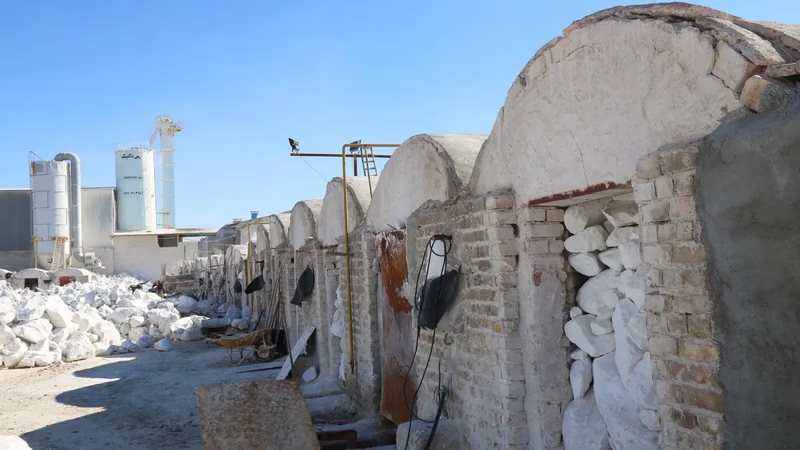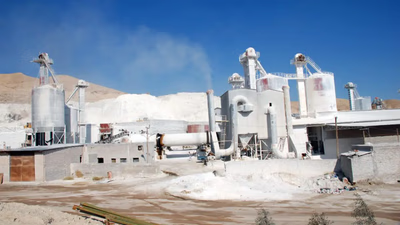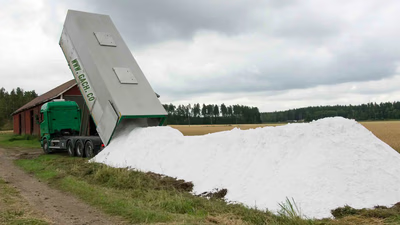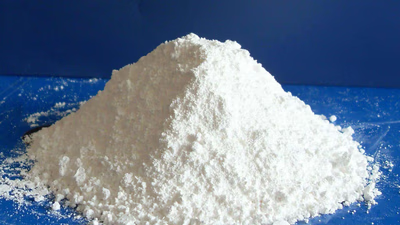
Plaster applications in construction and agriculture industries.
Plaster is extensively used in the construction industry for interior finishing and decorative purposes. It is commonly applied as a smooth coating on walls and ceilings to create a finished surface. Plaster is also used for creating ornamental elements, such as cornices, moldings, and ceiling roses. Gypsum plaster, in particular, is used for making plasterboard (drywall) panels, which are widely used for interior partition walls. Plaster has significant applications in the medical and dental fields. Plaster of Paris, a type of gypsum plaster, is used for making casts, splints, and bandages. It is commonly used to immobilize broken bones or create molds for prosthetic limbs. Dental professionals also use plaster for creating dental models and molds.
Plaster has agricultural applications, primarily in soil and crop management. Agricultural gypsum, which is a type of gypsum plaster, is utilized to improve soil structure and fertility. It is often applied to soils with high clay content to enhance drainage and reduce soil compaction. Gypsum can also help in reclaiming sodic or saline soils by improving their water-holding capacity and reducing sodium levels. Gypsum is used as a fertilizer additive to provide calcium and sulfur to the soil. It helps in improving plant growth, root development, and nutrient uptake. Gypsum also aids in reducing soil erosion and improving soil structure. Plaster finds applications in various industrial settings. It is used in the production of casts and molds for metal and glass manufacturing. Plaster molds are employed in processes like investment casting, where they create intricate shapes for metal casting.
Ca and S Calcium and sulfur in raw gypsum meet the needs of pistachio trees for these two elements. The presence of a rich source of calcium in the subsoil or surface soil in pistachio gardens increases the soil acidity and reduces Al poisoning in it. Removable and very light plaster particles in the soil will greatly help to improve it`s properties. Calcium ions in the soil will increase light soil particles and also soil conditioning and lightening. On the other hand, SO4 sulfate ions will increase the absorption of fixed and non-absorbable ions for trees. According to many theories of plant nutritionists, calcium and sulfur are one of the most consumed elements, and in this regard, adding calcium and sulfur to the soil will meet the needs of trees for these vital elements. Applications of plaster in agriculture are generally in the following cases:
- Preparation of chemical fertilizers
- Soil conditioner
- Preparation of chemical toxins
- Absorption of the soil moisture
- Improve soil structure and soften clay soils
- Supply of calcium required by plants
- Neutralization of sodium in alkaline soils
- Clarify the water of muddy ponds
- Activate microscopic creatures
- Supply of sulfur required by plants
According to above mentioned materials, plaster or gypsum is mainly used in construction industry mostly as a wall coating or for plastering artworks, but this useful material is also applicable in many industries such as agriculture, fertilizer, medicine, pharmaceutical, petrochemical, leather, glass, paper industries and so on. The use of raw plaster has an almost long history in agriculture and since 1768, i.e. about 250 years ago, plaster has been used to improve the soil. The use of plaster in agriculture has been popular in Europe since the 18th century on many crops, including grapes and apples.
Surprisingly, with all these extensive resources of raw plaster it`s use in some highly saline and alkaline pistachio garden and pistachio-prone areas is very low and even very insignificant. A substance that can work miracle in pistachio garden, of course, if used properly. Another advantage of using raw gypsum in pistachio gardens is the reduction of salinity and its modification in the rhizosphere of the roots of pistachio trees, and another advantage is the acidification of highly alkaline soil in pistachio prone areas.
Plaster is a popular material for art and sculpture. Artists use plaster to create sculptures, reliefs, and intricate molds. It provides a versatile and easily workable medium for artists to express their creativity. Plaster sculptures can be finished with various techniques, such as painting or gilding. Plaster plays a vital role in the ceramics and pottery industry. Plaster molds are used in the casting process to create ceramic objects. The liquid clay or slip is poured into the plaster mold, which absorbs the moisture, allowing the clay to solidify and take the shape of the mold. Plaster bats, which are flat plaster surfaces, are also used by potters for drying and working with clay.
-

Plaster and gypsum play a crucial role in the construction industry, primarily for interior wall and ceiling finishing. Gypsum plaster, or plaster of Paris, is mixed with water to create a smooth paste that can be applied to surfaces, providing an even base for painting or decorative finishes. It is also used for creating intricate decorative elements like moldings and cornices, enhancing the aesthetic appeal of spaces. In restoration projects, plaster helps replicate historic designs and repair damaged surfaces. Gypsum boards, commonly known as drywall, are widely utilized as an alternative to traditional plaster applications due to their ease of installation and fire-resistant properties. They contribute to soundproofing and thermal insulation in various settings such as theaters and conference rooms. Plaster can be applied over masonry surfaces to improve durability and weather resistance while offering a visually appealing finish. Additionally, modern construction often employs metal frameworks for interior walls where plaster can be directly applied.
The versatility of gypsum extends beyond construction; it is also significant in the cement industry for enhancing adhesion. Overall, plaster"s multifaceted applications make it indispensable in both new constructions and renovations. "
-

Plaster is a versatile material with significant applications across various industries, particularly in construction, agriculture, and healthcare. In the construction sector, plaster is primarily used for interior finishing, decorative elements, and creating plasterboard panels. Its role extends to the medical field where Plaster of Paris is utilized for making casts and dental molds. In agriculture, gypsum plaster improves soil structure and fertility, enhancing drainage and nutrient uptake while reducing soil compaction. It also plays a crucial role in reclaiming sodic soils and providing essential nutrients like calcium and sulfur to crops. The historical use of plaster in agriculture dates back over 250 years, yet its potential remains underutilized in certain regions like pistachio gardens. Additionally, plaster finds applications in industrial settings such as metal casting and ceramics, where it is used to create molds for intricate designs. Artists also favor plaster for its workability in sculpture creation.
Overall, plaster"s multifaceted uses highlight its importance across diverse sectors. "
-

Gypsum is a versatile mineral with applications across various industries, including agriculture, construction, healthcare, and manufacturing. In agriculture, it serves as a soil amendment that enhances soil structure and nutrient availability by providing essential calcium and sulfur. The construction industry utilizes gypsum in cement production to control setting times and improve the durability of concrete products. Additionally, gypsum is integral in creating plaster molds for ceramics and metal casting, as well as in producing lightweight concrete blocks. In healthcare, gypsum is used for dental molds and medical bandages due to its purity requirements. The food industry benefits from gypsum"s role in sugar production and beverage clarification. Furthermore, gypsum finds applications in the glass industry to regulate melt viscosity and in the petrochemical sector as a drying agent. Its use extends to the paper and paint industries for transparency enhancement and as a filler material. Gypsum"s adaptability makes it an essential component across multiple sectors, highlighting its importance in trade within the Middle East and West Asia.
-

Gypsum and plaster have been utilized for thousands of years, with significant applications in ancient civilizations such as Egypt, Greece, and Rome. The Egyptians used gypsum plaster for tombs and temples, while the Greeks and Romans advanced its use in decorative elements and construction techniques. During the Middle Ages, plasterwork became prominent in Europe, especially in castles and churches. The Renaissance saw a peak in elaborate plaster decorations. Evidence of gypsum use dates back to 9000 years ago in regions like Anatolia and Syria, showcasing its historical significance across various cultures. In modern times, gypsum remains crucial in construction for its fire resistance and sound insulation properties. The Industrial Revolution enhanced gypsum production methods, leading to the widespread adoption of drywall or plasterboard. Today, gypsum products are integral to residential, commercial, and industrial applications.
-

Gypsum plaster, or plaster of Paris, is derived from the mineral gypsum, a soft sulfate mineral composed of calcium sulfate dihydrate. This material is created by heating gypsum to eliminate water content, resulting in a dry powder that rehydrates when mixed with water. It forms a durable paste suitable for application on walls and ceilings. Gypsum is widely available globally, with major production in countries like the United States, China, and Iran. Building supply stores typically stock gypsum products in various forms, including powder and pre-mixed bags. Gypsum plaster is favored in construction for its smooth finish and fire-resistant properties but should not be used in moisture-prone areas due to deterioration risks. Its unique rehydration ability allows for easy repairs and adjustments. Online retailers also offer gypsum products, making it accessible for various construction needs. For bulk purchases or direct sourcing, contacting local mining companies or suppliers can be beneficial.





